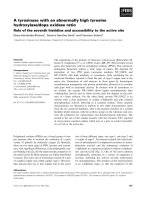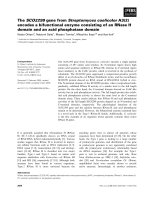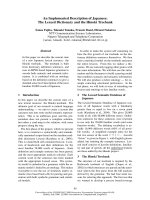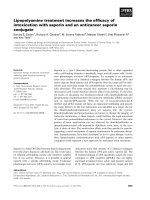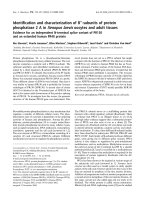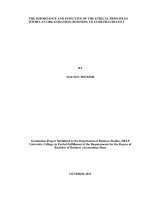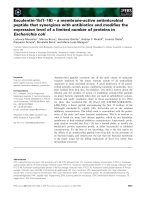The binomial formula and an extended number
Bạn đang xem bản rút gọn của tài liệu. Xem và tải ngay bản đầy đủ của tài liệu tại đây (10.31 MB, 25 trang )
DISCRETE MATH
Binomial formula
and an extended
3x + 2x
number
SUPERVISORS: PHD. TRAN NGUYEN AN
2x+1
MEMBERS
LƯU TÙNG
C
Ọ
G
N
G
N
Ồ
H
group 6
THU TRÀ
BÙI HIỀN
INTRODUCTION
Mathematics has a particularly important position in the subjects in high schools, it is the basis of
many other subjects. It is a subject that many students love because of its abstract thinking so that
they can freely discover new things when they go to learn it.
The application of the binomial formula has the effect of reviewing and systematizing knowledge
and affirming the practicality of the content of knowledge. If students practice solving this form of
math, it not only helps students master the mathematical knowledge system, but also contributes to
training math problem solving skills, skills to apply math knowledge to practice, and developing
mathematical thinking. study for students. With that in mind, my group's essay presents the topic:
''The binomial formula and an extended number''.
1. COMBINATION SYMBOL.
t
n
e
i
c
ffi
e
o
Binomial c
The symbol binomial coefficient is the coefficient of
in the binomial expansion.
Combinatorial formula.
In Mathematics, combinatorics is a way of selecting elements from a larger group regardless of the order. In smaller cases the
number of combinations can be counted. For example for three fruits, an apple, an orange and a pear, there are three ways to
combine the two fruits from this set: an apple and a pear; an apple and an orange; a pear and an orange. By definition, the
concatenation of n elements is a subset of the parent set S containing elements, the subset of k distinct elements belonging to
S and unordered. The number of convolutional combinations of n elements is equal to the binomial coefficient. We have the
formula
2. PASCAL'S TRIANGLE AND THE
FORMATION OF NEWTON'S BINOMIAL
FORMULA.
l
a
i
m
o
n
i
b
e
h
t
f
o
n
o
i
t
a
m
r
o
The f
formula.
- Special cases of the binomial theorem have been known since at least the 4th century BC,
when the Greek mathematician Euclid mentioned a special case of the binomial theorem for
the exponent of 2.
- Al-Karaji described the triangular model of the binomial coefficients and gave proofs for
the binomial theorem and Pascal's triangle by mathematical induction.
- In 1544, Michael Stifel introduced the term "binomial coefficients" and showed how to use
them to represent through using "Pascal's triangle".
- Newton is sometimes considered the founder of mathematical analysis.
2.2.NEWTON’S BINOMIAL
STORY.
-Newton Isaac found the following binomial expansion formula, which is called Newton's binomial.
-. In Europe, the arithmetic triangle was first found in the work of the German mathematician Stiffel M.
Published in 1544.
-One hundred years later, completely independent of each other, English mathematicians Borigon (1624),
French mathematician Fermat (1636) and French mathematician Pascal (1654) came up with the perfect
formula. about the coefficients of Newton's binomial
Pascal Triangle
- In mathematics, Pascal's triangle is a triangular array of
binomial coefficients
-The rows of Pascal's triangle are listed by convention starting
with the top row n=0 (row 0). The entries in each row are
numbered from the left end with k=0 and are often staggered
relative to the numbers in adjacent rows.
-In row 0 (top row), there is a unique 1. Each number of each
subsequent row is constructed by adding the number above and
to the left with the number above and to the right, treating
empty entries as 0.
n=0
1
n=1
1
n=2
1
n=3
1 3
n=4
n=5
1
1
1
2
4 6
5
1
3
1
4
1
10 10 5 1
Prove by induction on variable n. The formula =
-With n=0, we have =1= Assume the formula is correct in the case of 0N, with N, now we will go to prove it correctly in case n=N+1. Realyy, we have: = = 1 =
=
- With case 1 k N we have = +. According to the inductive assumption,
the formula holds for the case n, so that == =
Thence inferred =
PROVE NEWTON’S BINOMIAL FORMULA.
n
le
ab
ri
va
on
on
ti
uc
d
in
by
e
ov
Pr
With n=0, n=1 it is obvious that we have soething to prove. Assume the formula is correct in the case of 0 n N, with N, now we will
go to prove it correctly in case n=N+1. We have
Notice that according to Pascal's triangle construction formula, we have:
. So we have proved the correct formula for the case n=N+1
3.SOME BASIC PROPERTIES
Recalling Newton's binomial Session
Theorem: With a, b being real numbers and n being positive integers, we have
In the expression on the right hand side of formula (1) we have
a) Number of terms là n+1.
b) The number of terms with the exponent of a decreasing from n to 0, the exponent of b increasing from 0 to n, but the sum of the exponents of
a and b in each term is always n.
c) The coefficients of each term equidistant from the first and last two terms are equal.
Consequences
1.With a=b=1, we have
2. With a = 1; b = -1, we have 0=
BASIC FORMULAS RELATING TO NEWTON BINOMIAL DEVELOPMENT
ALSO WE HAVE SOME OTHER RECIPES AS FOLLOWING.
In addition, from the formula k. we can expand the
following formula
Signs of problems using Newton's binomial in proof of equality problems.
- When it is necessary to prove an equality or inequality where and i are consecutive natural
numbers.
-
If the problem is for expansion
then the coefficient of is such that the equation a (n−i)+bi=m has a solution i∈N
- In the expression then we multiply both sides by and then take the derivative.
- In the expression then we choose the appropriate value of x=a.
4.SOME EXTENSIONS OF THE BINOMIAL
FORMULA
1,Polynomial formula
).() =
+ =
3,
n
4, +...+ ) = . . . . .
5. MATHEMATICAL FORMS RELATED TO
NEWTON'S BINOMIAL.
CONSISTS OF
•
The problem of binomial expansion and the proof of
fundamental equality.
•
•
•
The problem of the largest coefficient.
Prove the equality.
Application of derivatives in the proof of combinatorial
equality.
•
•
Application of integrals in the proof of combinatorial equality.
Application of complex numbers to prove combinatorial
equality
6. SELF PRACTICE EXERCISES
7. CONCLUSION.
In the current university's advanced math program, discrete modules play an important role and are distributed right from the first
semester. In it, the binomial formula and some of its extensions play a dominant role. It helps to solve many problems in many fields.
Therefore, binomial formulas and some extensions have many wide applications in life.
In the process of studying the essay due to limited time, after completing the essay, we still continue to study more deeply about the
binomial formula and some extensions. We are looking forward to receiving suggestions from teachers to improve our essay.
Thank You!
See you in our next presentation.


